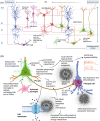The fate of interneurons, GABAA receptor sub-types and perineuronal nets in Alzheimer's disease
- PMID: 36409151
- PMCID: PMC9836378
- DOI: 10.1111/bpa.13129
The fate of interneurons, GABAA receptor sub-types and perineuronal nets in Alzheimer's disease
Abstract
Alzheimer's disease (AD) is the most common neurological disease, which is associated with gradual memory loss and correlated with synaptic hyperactivity and abnormal oscillatory rhythmic brain activity that precedes phenotypic alterations and is partly responsible for the spread of the disease pathology. Synaptic hyperactivity is thought to be because of alteration in the homeostasis of phasic and tonic synaptic inhibition, which is orchestrated by the GABAA inhibitory system, encompassing subclasses of interneurons and GABAA receptors, which play a vital role in cognitive functions, including learning and memory. Furthermore, the extracellular matrix, the perineuronal nets (PNNs) which often go unnoticed in considerations of AD pathology, encapsulate the inhibitory cells and neurites in critical brain regions and have recently come under the light for their crucial role in synaptic stabilisation and excitatory-inhibitory balance and when disrupted, serve as a potential trigger for AD-associated synaptic imbalance. Therefore, in this review, we summarise the current understanding of the selective vulnerability of distinct interneuron subtypes, their synaptic and extrasynaptic GABAA R subtypes as well as the changes in PNNs in AD, detailing their contribution to the mechanisms of disease development. We aim to highlight how seemingly unique malfunction in each component of the interneuronal GABA inhibitory system can be tied together to result in critical circuit dysfunction, leading to the irreversible symptomatic damage observed in AD.
Keywords: Alzheimer's disease; GABA; Synaptic; interneurons; neurodegeneration; perineuronal nets.
© 2022 The Authors. Brain Pathology published by John Wiley & Sons Ltd on behalf of International Society of Neuropathology.
Conflict of interest statement
The authors declare no conflict of interest.
Figures

Similar articles
-
Decreased extrasynaptic δ-GABAA receptors in PNN-associated parvalbumin interneurons correlates with anxiety in APP and tau mouse models of Alzheimer's disease.Br J Pharmacol. 2024 Oct;181(20):3944-3975. doi: 10.1111/bph.16441. Epub 2024 Jun 17. Br J Pharmacol. 2024. PMID: 38886118
-
Electroacupuncture Ameliorates Cognitive Impairment by Regulating γ-Amino Butyric Acidergic Interneurons in the Hippocampus of 5 Familial Alzheimer's Disease Mice.Neuromodulation. 2024 Jun;27(4):730-741. doi: 10.1016/j.neurom.2022.11.014. Epub 2023 Jan 4. Neuromodulation. 2024. PMID: 36604241
-
Aberrant Excitatory-Inhibitory Synaptic Mechanisms in Entorhinal Cortex Microcircuits During the Pathogenesis of Alzheimer's Disease.Cereb Cortex. 2019 Apr 1;29(4):1834-1850. doi: 10.1093/cercor/bhz016. Cereb Cortex. 2019. PMID: 30766992 Free PMC article.
-
Epileptic Mechanisms Shared by Alzheimer's Disease: Viewed via the Unique Lens of Genetic Epilepsy.Int J Mol Sci. 2021 Jul 1;22(13):7133. doi: 10.3390/ijms22137133. Int J Mol Sci. 2021. PMID: 34281185 Free PMC article. Review.
-
Losing the sugar coating: potential impact of perineuronal net abnormalities on interneurons in schizophrenia.Schizophr Res. 2015 Sep;167(1-3):18-27. doi: 10.1016/j.schres.2014.12.040. Epub 2015 Jan 16. Schizophr Res. 2015. PMID: 25601362 Free PMC article. Review.
Cited by
-
Linking Social Cognition, Parvalbumin Interneurons, and Oxytocin in Alzheimer's Disease: An Update.J Alzheimers Dis. 2023;96(3):861-875. doi: 10.3233/JAD-230333. J Alzheimers Dis. 2023. PMID: 37980658 Free PMC article. Review.
-
The Role of Cerebellar Intrinsic Neuronal Excitability, Synaptic Plasticity, and Perineuronal Nets in Eyeblink Conditioning.Biology (Basel). 2024 Mar 21;13(3):200. doi: 10.3390/biology13030200. Biology (Basel). 2024. PMID: 38534469 Free PMC article. Review.
-
Quantification and correlation of amyloid-β plaque load, glial activation, GABAergic interneuron numbers, and cognitive decline in the young TgF344-AD rat model of Alzheimer's disease.Front Aging Neurosci. 2025 Feb 12;17:1542229. doi: 10.3389/fnagi.2025.1542229. eCollection 2025. Front Aging Neurosci. 2025. PMID: 40013092 Free PMC article.
-
Advances in Therapeutics to Alleviate Cognitive Decline and Neuropsychiatric Symptoms of Alzheimer's Disease.Int J Mol Sci. 2024 May 9;25(10):5169. doi: 10.3390/ijms25105169. Int J Mol Sci. 2024. PMID: 38791206 Free PMC article. Review.
-
The Pathophysiological Underpinnings of Gamma-Band Alterations in Psychiatric Disorders.Life (Basel). 2024 Apr 30;14(5):578. doi: 10.3390/life14050578. Life (Basel). 2024. PMID: 38792599 Free PMC article. Review.
References
-
- Walters A, Phillips E, Zheng R, Biju M, Kuruvilla T. Evidence for neuroinflammation in Alzheimer's disease. Prog Neurol Psychiatry. 2016;20:25–31.
-
- Busche MA, Eichhoff G, Adelsberger H, Abramowski D, Wiederhold KH, Haass C, et al. Clusters of hyperactive neurons near amyloid plaques in a mouse model of Alzheimer's disease. Science. 2008;321:1686–9. - PubMed
Publication types
MeSH terms
Substances
Grants and funding
LinkOut - more resources
Full Text Sources
Medical

